Ever walked into a party and been instantly drawn to the colorful spread on the table? That’s the magic of a Vegetarian Mezze Platter! Packed with bold flavors, vibrant colors, and a variety of textures, it’s like a Mediterranean vacation on a plate. Did you know mezze culture dates back over a thousand years and is still one of the most popular dining traditions in Greece, Turkey, and the Middle East?
Whether you’re a seasoned home cook or someone who just loves to eat (no judgment here), a mezze platter is a winning choice. In this guide, we’ll break down the essential components, plating tips, and flavor pairings — so you can create your own irresistible vegetarian mezze spread that will have everyone asking for seconds.
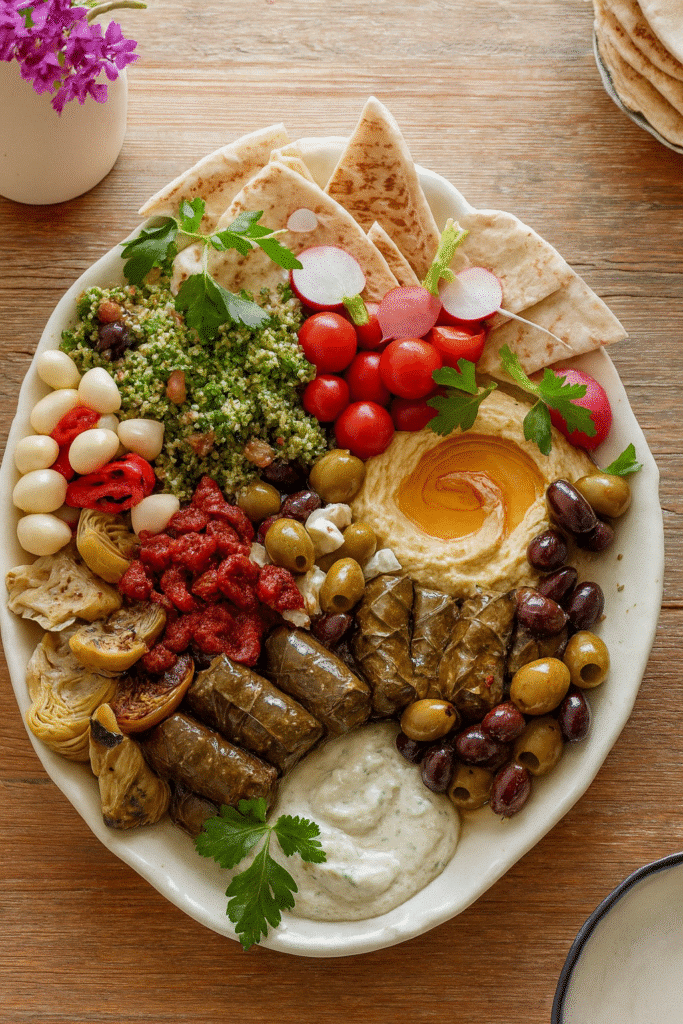
What is a Vegetarian Mezze Platter?
The first time I ever had a real mezze platter was at this tiny family-run restaurant in Istanbul. I’d ordered it thinking it would be a few dips and some bread. What came out, though, was a feast — and I mean, the kind of spread that makes you pause before digging in because it’s just too beautiful to touch. That’s when I realized a Vegetarian Mezze Platter isn’t just “food on a plate.” It’s a celebration.
A mezze platter, at its core, is a collection of small dishes — think of it like the Mediterranean and Middle Eastern cousin of Spanish tapas. But here’s the kicker: unlike tapas, mezze often makes up an entire meal. No need for a main course because the variety is the main event. When you go vegetarian with it, you’re talking creamy hummus, smoky baba ganoush, bright tabbouleh, crunchy falafel, pickled vegetables, soft pita bread… and that’s just the start.
I’ll admit, I used to think a vegetarian version might be “missing something.” Spoiler: I was wrong. The thing about mezze is that it’s all about flavors and textures working together — you don’t need meat to make it satisfying. In fact, leaving meat out makes it lighter, fresher, and perfect for sharing without that post-meal food coma.
Here’s what I love about it:
- It’s interactive. People don’t just sit and eat; they build bites, try combos, and talk about it.
- It’s customizable. If you’ve got friends who are picky or have dietary restrictions, you can easily swap things in and out.
- It’s beautiful. Seriously, the colors and textures make for some Instagram-worthy table spreads.
And the cultural roots run deep. Mezze has been a social dining tradition for over a thousand years in countries like Greece, Lebanon, and Turkey. It’s the kind of meal that’s as much about connection as it is about taste. You don’t rush through it. You linger. You dip bread, pass olives, share stories.
One thing I learned the hard way — don’t try to overload the platter with everything. The magic is in variety, but too much variety becomes chaos. Five or six main items, plus bread and maybe a couple of small garnishes, hits that sweet spot.
If you’re new to mezze, I’d say start simple: a few spreads, a couple of fresh vegetables, one or two cooked items, and some olives or pickles. Once you’ve got the hang of arranging and balancing the flavors, you can go wild with more adventurous things like muhammara or stuffed grape leaves.
And here’s my biggest tip: make it look as good as it tastes. Arrange it so people’s eyes light up when they see it. That first visual impression is half the fun.
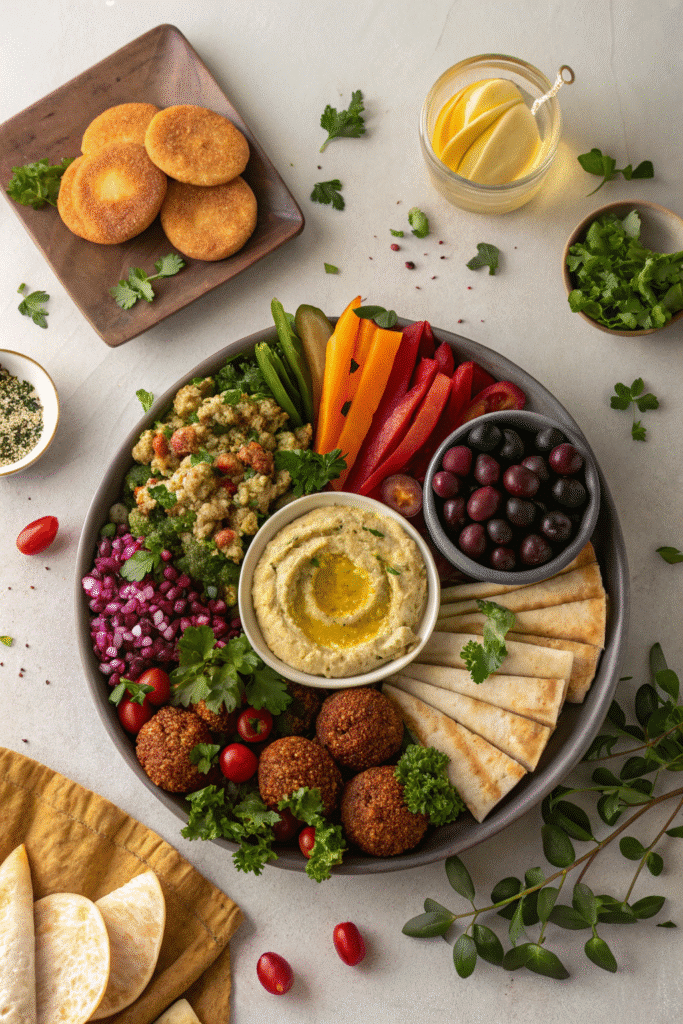
Essential Dips & Spreads
If there’s one thing that makes a Vegetarian Mezze Platter unforgettable, it’s the dips. I swear, you could hand me a stack of warm pita and three bowls of well-made spreads, and I’d be set for the night. No shame in that.
Hummus — The Crowd Favorite
Let’s start with the obvious superstar — hummus. I’m convinced there are two kinds of people in this world: those who make their hummus silky-smooth, and those who leave it a little chunky for texture. I’m a smooth hummus person, personally.
Pro tip: Peel your chickpeas before blending. Yes, it’s a little tedious, but you’ll be rewarded with the creamiest dip you’ve ever had. And don’t be afraid to get creative — roasted red pepper hummus, beetroot hummus that turns hot pink, or even spiced pumpkin hummus in the fall.
Baba Ganoush — Smoky and Rich
Then there’s baba ganoush, the smoky eggplant dip that somehow manages to be both light and decadent. The first time I roasted the eggplant over an open flame, my kitchen smelled like a Mediterranean street market — in the best way.
That charred flavor? Completely worth the mess. If you’re in a pinch, you can roast in the oven, but I promise, fire-roasting takes it to another level.
Labneh — The Creamy Secret Weapon
Labneh might just be my secret weapon. It’s technically a strained yogurt cheese, so it’s tangy, creamy, and ridiculously easy to make at home. Drizzle it with olive oil, sprinkle za’atar on top, and watch it disappear in minutes.
I once served labneh at a party and had someone ask if it was “fancy cream cheese.” I just smiled and handed them more bread.
Muhammara — Sweet, Spicy, and Nutty
For a little heat and sweetness, muhammara is a must. Made from roasted red peppers, walnuts, and pomegranate molasses, it has this amazing depth — smoky, nutty, tangy, all in one bite.
It’s one of those dips that people try once and then immediately ask for the recipe.
How Many Dips is Enough?
A good rule of thumb? Aim for at least three dips on your platter. Each one should bring something different to the table:
- Creamy and mild (hummus or labneh)
- Smoky and rich (baba ganoush)
- Bold and tangy (muhammara or something spicy)
And if you’re feeling extra, throw in a herbed feta spread, tzatziki, or even a small bowl of olive tapenade.
The trick is balance. Too many strong flavors and you’ll overpower the whole platter. But get the mix right, and you’ll have a spread so good, people will skip the other dishes entirely. True story — I’ve seen a mezze platter reduced to just bread crumbs and an empty muhammara bowl in under 15 minutes.

Fresh & Roasted Vegetables
A Vegetarian Mezze Platter without vegetables? Not happening. Veggies are the color, the crunch, and the freshness that balance all those creamy dips and rich breads. Honestly, they’re the unsung heroes of a good mezze spread.
Seasonal Choices Make All the Difference
The easiest way to make your platter pop is to go seasonal. In spring, I’m all about radishes, baby carrots, and tender asparagus. Summer? Bring on the cherry tomatoes, cucumbers, and grilled zucchini. Fall and winter lean more into roasted bell peppers, cauliflower, and squash.
Fresh vegetables don’t just look good; they bring a refreshing bite between those heavier items like falafel or stuffed grape leaves. Trust me, no one has ever complained about too much crunch.
Roasting for Depth and Flavor
Here’s my little secret: roast your veggies with Middle Eastern spices and a drizzle of good olive oil. A mix of paprika, cumin, coriander, and a pinch of cinnamon will transform plain old carrots into something guests can’t stop picking at.
And don’t be shy with the roasting — that caramelized edge is flavor gold. I once served roasted eggplant slices that were gone before the pita bread even got touched.
Raw Veggies for Crisp Contrast
While roasted vegetables bring warmth and depth, raw vegetables bring freshness and snap. Cucumber slices, crisp bell pepper strips, and halved cherry tomatoes are easy wins. They also double as edible “spoons” for scooping up dips — which is especially handy when you’ve run out of pita (and yes, that happens more than you’d think).
I usually aim for a mix: half the vegetables raw, half roasted. That way, you get the best of both worlds.
Balancing Flavors and Textures
A great mezze platter is all about contrast. Pair creamy hummus with crunchy carrots. Serve smoky baba ganoush alongside juicy cucumber. Layer sweet roasted red peppers next to tangy labneh.
You want each bite to feel different from the last — a little adventure for the taste buds. The variety is what keeps people lingering at the table, trying “just one more” combo.
A Quick Pro Tip
Don’t overcomplicate your vegetable selection. Three to five fresh options and two to three roasted ones are plenty. Too many choices and the platter starts feeling like a grocery store aisle instead of a curated feast.
Oh, and always have extra vegetables on standby in the fridge. I’ve had guests demolish the veggie portion before touching the bread — and nothing’s sadder than a half-empty platter halfway through the night.
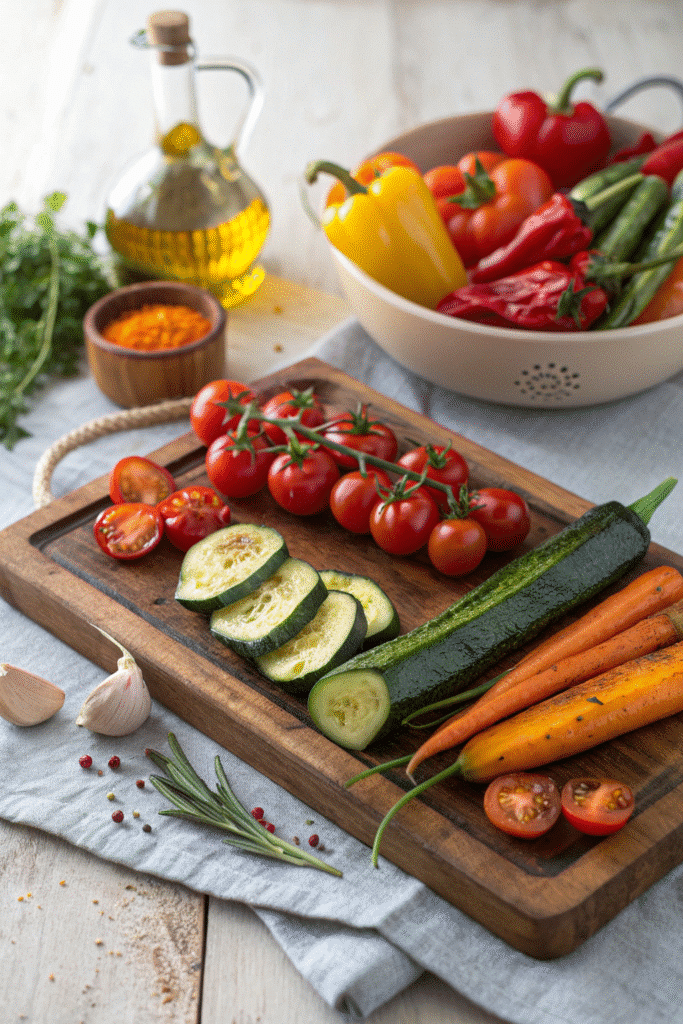
Breads & Accompaniments
A Vegetarian Mezze Platter without bread is like a beach without sand — you can still enjoy it, but something’s definitely missing. Bread is the bridge between all those dips, veggies, and spreads. And in mezze, it’s not just a side — it’s an essential part of the experience.
Pita Bread — The Classic Choice
Soft, pillowy pita bread is the undisputed champion of mezze carbs. Fresh out of the oven (or even just warmed in a skillet), it’s perfect for scooping up hummus, wrapping around falafel, or swiping through baba ganoush.
If you can, get your hands on freshly baked pita from a bakery or Middle Eastern market. Store-bought works in a pinch, but fresh pita? That’s next-level. I’ve had guests literally fight over the last warm slice.
Lavash & Other Flatbreads
Lavash is thinner and a little chewier than pita, making it great for rolling up with spreads and roasted veggies. I like to cut it into triangles, brush it lightly with olive oil, sprinkle with za’atar, and bake it until crisp. Instant pita chips, but with personality.
Other flatbreads like naan or focaccia can work too, though they lean more fusion than traditional. Still, if they’re warm and fresh, nobody’s complaining.
Dolmas — Flavor in Every Bite
Stuffed grape leaves, or dolmas, might not technically be bread, but they deserve a spot in the “accompaniments” category. Filled with rice, herbs, and sometimes pine nuts, they’re tangy, savory, and surprisingly filling. I’ve found they pair beautifully with a dollop of tzatziki or labneh.
Olives & Pickles — The Bright Counterpoint
You can’t skip the briny stuff. A mix of green and black olives brings saltiness and richness, while pickled vegetables — like turnips, cucumbers, or peppers — cut through the heavier elements on the platter.
Pro tip: put olives in a separate small bowl so their brine doesn’t make your bread soggy. Learned that one the hard way.
Why Variety Matters Here
You don’t need every bread option under the sun, but having at least two types (say, pita and lavash) makes a big difference. Variety keeps guests interested and gives them more ways to build different flavor combinations.
For a party of 6–8, I usually go with:
- Fresh pita bread (2–3 rounds per person)
- Lavash chips (a big bowl)
- A small plate of dolmas
- One bowl of mixed olives and pickles
That lineup hits soft, chewy, crispy, tangy, and briny all in one go.

How to Arrange a Stunning Mezze Platter
I’ll be honest: arranging a Vegetarian Mezze Platter is basically edible art. You’re not just feeding people; you’re giving them that “wow” moment when they walk in and see the table. And the good news? You don’t have to be a professional food stylist to pull it off — just a little attention to color, texture, and balance goes a long way.
Start with the Big Stuff
I always begin by placing the dips and spreads in small bowls or ramekins. These are your anchors. Position them evenly across the platter so people can reach from any angle.
Hot tip — don’t cram them all in the middle. Spread them out so they draw the eye around the board. This makes the whole platter look fuller and more inviting.
Build Around Your Dips
Once the dips are in place, add your breads and cooked items (like falafel or dolmas) next. Keep them close to complementary dips — pita near hummus, dolmas near tzatziki or labneh. It feels intentional, and it’s easier for guests to make combinations without hunting for the right pairing.
Play with Color and Height
One trick I learned from a caterer friend: never let two items of the same color sit side-by-side. Separate reds, greens, and browns so the platter feels lively.
Also, don’t be afraid to stack or layer. A pile of bright orange carrot sticks leaning against a bowl, or roasted peppers nestled into a little mound — these touches create visual dimension that keeps the platter from looking flat.
Leave Breathing Room
It’s tempting to pack every square inch, but leaving a little space between items makes it easier for guests to grab things without knocking over a pile of cucumbers. Plus, it keeps your carefully plated masterpiece from turning into a jumbled mess halfway through the evening.
Garnish Like You Mean It
Herbs are your best friend here. Sprinkle chopped parsley over hummus, tuck sprigs of mint around the edges, or scatter pomegranate seeds for a jewel-like sparkle. A drizzle of good olive oil over baba ganoush instantly makes it look richer.
Final Touch — Make It Accessible
Arrange so guests can grab from every angle, especially if you’re placing the platter in the middle of a table. And always have extra bread and vegetables nearby so you can quietly replenish without dismantling the display.
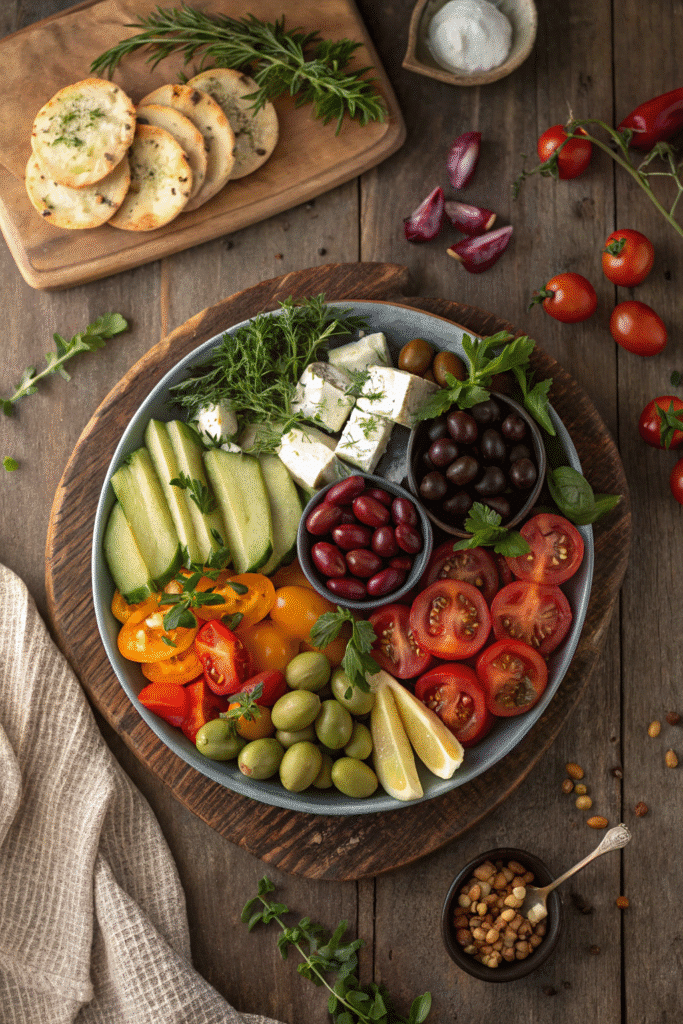
A Vegetarian Mezze Platter isn’t just food — it’s an experience. From the creamy hummus to the crispy falafel and the bright crunch of fresh veggies, every bite tells a story of flavor and tradition. Whether you serve it at a casual get-together or as the star of a dinner party, it’s guaranteed to impress. Now grab your favorite platter, start layering those delicious components, and don’t forget to share your beautiful creation on Pinterest so more people can get inspired!
Print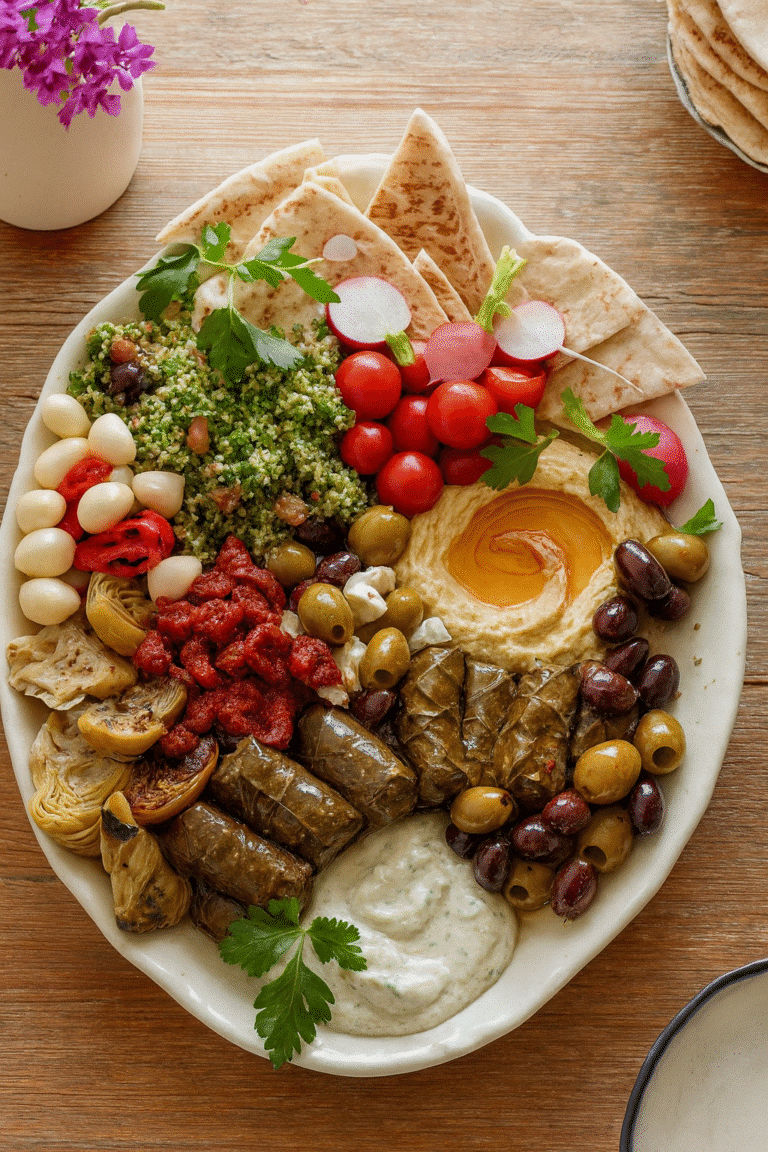
Vegetarian Mezze Platter
A vibrant and flavorful Mediterranean-inspired spread featuring creamy dips, fresh and roasted vegetables, breads, and accompaniments — perfect for sharing.
- Total Time: 1 hour
- Yield: 6-8 servings
Ingredients
- Hummus
- Baba ganoush
- Labneh with olive oil and za’atar
- Muhammara
- Fresh pita bread
- Lavash or flatbread
- Dolmas (stuffed grape leaves)
- Mixed olives
- Pickled vegetables
- Fresh vegetables: cucumber slices, cherry tomatoes, bell pepper strips, radishes
- Roasted vegetables: carrots, zucchini, eggplant, bell peppers (seasoned with paprika, cumin, coriander, cinnamon)
- Fresh herbs (parsley, mint) for garnish
Instructions
- Prepare at least three dips, ensuring a balance of creamy, smoky, and tangy flavors (e.g., hummus, baba ganoush, muhammara).
- Wash and slice fresh vegetables for dipping and garnish.
- Roast seasonal vegetables with olive oil and Middle Eastern spices until caramelized.
- Warm pita bread and cut lavash into triangles; bake lavash with olive oil and za’atar if desired.
- Arrange dips in small bowls and space them evenly across a large platter or board.
- Place breads, roasted vegetables, and cooked items (e.g., dolmas) around complementary dips.
- Fill gaps with fresh vegetables, olives, and pickled vegetables for variety and color.
- Garnish dips and platter with fresh herbs, olive oil drizzle, or pomegranate seeds.
- Serve immediately, replenishing bread and vegetables as needed.
Notes
Aim for variety without overcrowding the platter. Arrange for visual appeal and balance of flavors. Keep extra vegetables and bread ready to replenish during serving.
- Prep Time: 40 minutes
- Cook Time: 20 minutes
- Category: Appetizer
- Method: No-Cook & Roasting
- Cuisine: Mediterranean
- Diet: Vegetarian
Nutrition
- Serving Size: 1/8 of platter
- Calories: 300
- Sugar: 5g
- Sodium: 550mg
- Fat: 18g
- Saturated Fat: 4g
- Unsaturated Fat: 13g
- Trans Fat: 0g
- Carbohydrates: 28g
- Fiber: 6g
- Protein: 8g
- Cholesterol: 10mg


